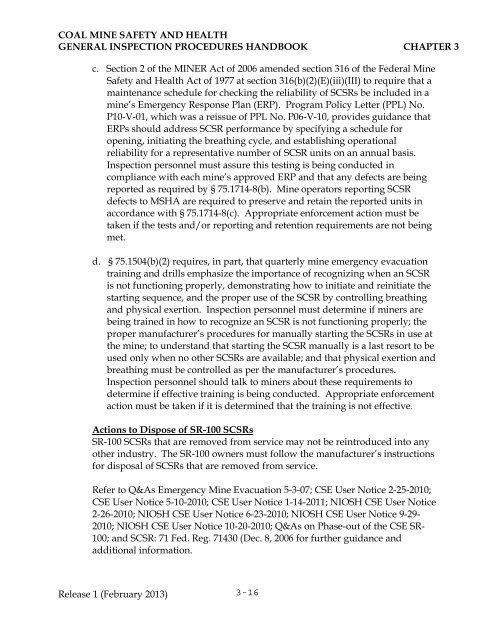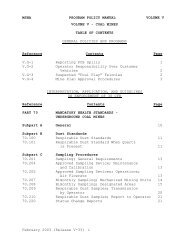MSHA HANDBOOK SERIES - PH13-V-1 - Mine Safety and Health ...
MSHA HANDBOOK SERIES - PH13-V-1 - Mine Safety and Health ...
MSHA HANDBOOK SERIES - PH13-V-1 - Mine Safety and Health ...
You also want an ePaper? Increase the reach of your titles
YUMPU automatically turns print PDFs into web optimized ePapers that Google loves.
COAL MINE SAFETY AND HEALTH<br />
GENERAL INSPECTION PROCEDURES <strong>HANDBOOK</strong> CHAPTER 3<br />
c. Section 2 of the MINER Act of 2006 amended section 316 of the Federal <strong>Mine</strong><br />
<strong>Safety</strong> <strong>and</strong> <strong>Health</strong> Act of 1977 at section 316(b)(2)(E)(iii)(III) to require that a<br />
maintenance schedule for checking the reliability of SCSRs be included in a<br />
mine’s Emergency Response Plan (ERP). Program Policy Letter (PPL) No.<br />
P10-V-01, which was a reissue of PPL No. P06-V-10, provides guidance that<br />
ERPs should address SCSR performance by specifying a schedule for<br />
opening, initiating the breathing cycle, <strong>and</strong> establishing operational<br />
reliability for a representative number of SCSR units on an annual basis.<br />
Inspection personnel must assure this testing is being conducted in<br />
compliance with each mine’s approved ERP <strong>and</strong> that any defects are being<br />
reported as required by § 75.1714-8(b). <strong>Mine</strong> operators reporting SCSR<br />
defects to <strong>MSHA</strong> are required to preserve <strong>and</strong> retain the reported units in<br />
accordance with § 75.1714-8(c). Appropriate enforcement action must be<br />
taken if the tests <strong>and</strong>/or reporting <strong>and</strong> retention requirements are not being<br />
met.<br />
d. § 75.1504(b)(2) requires, in part, that quarterly mine emergency evacuation<br />
training <strong>and</strong> drills emphasize the importance of recognizing when an SCSR<br />
is not functioning properly, demonstrating how to initiate <strong>and</strong> reinitiate the<br />
starting sequence, <strong>and</strong> the proper use of the SCSR by controlling breathing<br />
<strong>and</strong> physical exertion. Inspection personnel must determine if miners are<br />
being trained in how to recognize an SCSR is not functioning properly; the<br />
proper manufacturer’s procedures for manually starting the SCSRs in use at<br />
the mine; to underst<strong>and</strong> that starting the SCSR manually is a last resort to be<br />
used only when no other SCSRs are available; <strong>and</strong> that physical exertion <strong>and</strong><br />
breathing must be controlled as per the manufacturer’s procedures.<br />
Inspection personnel should talk to miners about these requirements to<br />
determine if effective training is being conducted. Appropriate enforcement<br />
action must be taken if it is determined that the training is not effective.<br />
Actions to Dispose of SR-100 SCSRs<br />
SR-100 SCSRs that are removed from service may not be reintroduced into any<br />
other industry. The SR-100 owners must follow the manufacturer’s instructions<br />
for disposal of SCSRs that are removed from service.<br />
Refer to Q&As Emergency <strong>Mine</strong> Evacuation 5-3-07; CSE User Notice 2-25-2010;<br />
CSE User Notice 5-10-2010; CSE User Notice 1-14-2011; NIOSH CSE User Notice<br />
2-26-2010; NIOSH CSE User Notice 6-23-2010; NIOSH CSE User Notice 9-29-<br />
2010; NIOSH CSE User Notice 10-20-2010; Q&As on Phase-out of the CSE SR-<br />
100; <strong>and</strong> SCSR: 71 Fed. Reg. 71430 (Dec. 8, 2006 for further guidance <strong>and</strong><br />
additional information.<br />
Release 1 (February 2013) 3-16
















